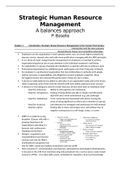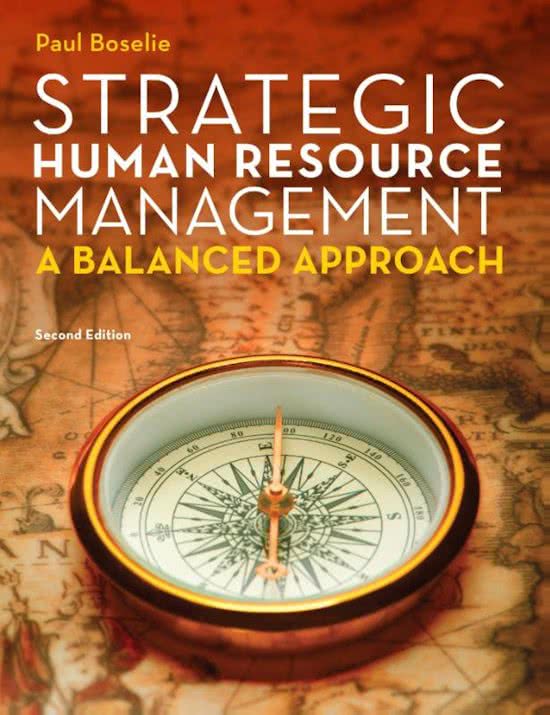Strategic Human Resource
Management
A balances approach
P. Boselie
Chapter 1 Introduction: Strategic Human Resource Management in the Twenty-first Century
Introduction and the new economy
Organizational change and competitive advantage
Employees are the organization’s most valuable assets; you can create higher productivity,
improve service, expand sales and make more profit when managing with the HRM principles
It is in times of major change that the management of employees is essential to achieve
organizational goals but also to pay attention to the individual employee’s well-being
An organization is a group of people who decided to co-operate with aim to achieve a goal.
Professional organization has additional goals: participants earn their living and continuity
An employer is a professional organisation that has relationships or authority with people
and has accessory responsibilities and obligations (several employers expertise; those
are hygiene factors who only benefit performance if they are not in order)
A person is employable he has ability to add value to an organisation today and in the future,
while recognising value of the work for himself (with work ability achieved career success)
A resource is everything you need to create what you sell but what does an individual need?
- Need for autonomy: Ability to self-organize one’s behaviour
- Need for competence: Feeling of being skilled and able to master and effectively
deal with one’s work environment (e.g. job challenge)
- Need for relatedness: To be connected and associated with others. Having the
sense of being significant to others and a member of a group
- Need for structure: Low tolerance for ambiguity and preference for well-ordered
- Need for safety: Feeling able to show and employ one's self without fear of
negative consequences to self-image, status, or career
SHRM is a relatively young
discipline (25years old) with a
growing importance for
organizations operating in a
dynamic and continuously
changing environment
Mergers, acquisitions and
reorganizations have become
common not only for MNC’s
(multinational companies) but
also for SME’s (small and medium enterprises) and non profit
New economy (IT, communication and financial), stimulated by technological developments,
is focused on the shift from manufacturing and production into a service sector assets-based
economy (1990s) – less observable assets, embedded in reputation, brand and knowledge
, Work in old economy (steel, construction, motor) was characterized by physical tasks, job
design and work based on mass production, low skilled workers and high unionization
Unionization is the act or process of organizing workers to become members of a trade union
Old economy still exists in developing countries and countries with cheap labour conditions
Outsourcing and offshoring activities to developing countries is typical for the new economy
Competitive advantage is an organization’s position in comparison to its direct
competitors, this is important for organizational survival and partly manageable by HRM
Competitive advantage
represents a relative outcome;
organization with competitive
advantage is doing better than its
competitors irrespective of the
firms performance
HRM as a staff function has NO
direct influence on performance
Influence performance by balancing daily dynamics of organisation (continuous movement),
enhancing employability (communicate, connect and provide) and looking ahead
Factors for continuity are healthy, good, agile, flexible, connected and balanced
The changing role of work in modern organizations
MHRM, IHRM and SHRM
Working at home can be a source for a better family-friendly , work-life balance
Flexible working arrangements are becoming more important for dual-career couples
Benefits are for the employee (improved planning) and the employer (work-life balance)
Ageing population is affecting work with regard to potential loss of knowledge, skills, abilities
and increasing labour costs (age above 50) to older workers in terms of higher salaries
SHRM can be a key to success in the process of organizational change; e.g. selecting top
talent, rewarding excellent performance, development and culture management
HRM involves management decisions related to policies and practices that shape relationship
The balanced approach in HRM is in achieving individual, organizational and societal goals
Above definition acknowledges relevance of different stakeholders and goals linked to them
Others state that HRM is the management of work and people towards desirable ends, this
being a fundamental activity in any organization with human beings as employees
There are three major sub fields to identify in HRM:
- MHRM: Micro HRM. The sub-functions of HR policy and practice; including
recruitment and selection, induction, socialization, training and
development. Closely related to studies in organizational behaviour
and occupational psychology that focus on the impact of single
HR practices on employees attitudes and behaviour
- IHRM: International HRM. HRM In MNC’s and HRM across borders. Focuses
on transferability of HR practices across business units in different
countries, optimal management of expatriates (person living outside
native country) and impact of institutional country contexts on HRM
- SHRM: Builds on definition of HRM. Focuses on linking HRM to business
strategy, designing high-performance work systems (HPWS’s) and
adding value through good people management in an attempt to gain
sustained competitive advantage. Pays attention to organizational
, context; alignment of the institutional context and HRM, linkage
between business systems and HRM and fit between HR practices
Sustainable SHRM is a long-term and multiple stakeholder perspective
Induction is welcoming employees and supporting to adjust to new roles and environments.
Legislation affects HRM e.g. through laws on labour flexibility, working conditions, safety,
collective bargaining agreement (CBA’s) (CAO’s) and unemployment regulations
Stakeholders of an organization represent all groups inside and outside an organization that
can affect its strategy and goals; distinction between internal stakeholders (employees,
management, representatives) and external stakeholders (financiers, unions, government)
Three perspectives and tensions
The multidimensional strategic HR model in the book includes these key characteristics:
- A multi-actor perspective: Multiple stakeholders including employees,
managers, HR professionals, work councils, unions,
shareholders, financiers and government
- A broad societal view: Emphasis on different institutional context e.g. on the
level of branches of industry, regions and countries
- A multi-level perspective: Including the individual employee perspective and
the strategic organizational perspective
This is a normative (standard), multidimensional perspective that is different from models
presented (by mostly US Scholars) who put a heavy emphasis on shareholder value
This model in inspired by the European approaches to HRM and industrial relations (IR)
Industrial or employment relations are formal and informal rules which regulate employment
relationship; institutionalisation and regulating the incomplete labour contract
Actors in IR are government, trade unions, works councils and employers
IR focuses regulating power imbalances, conflicts; protection and development employees
Tendency to bargain on decentralized company level instead of sectoral level
This approached is reflected by Paauwe, who argues that:
- HR is more than resources: Human resources are people with feelings, emotions,
interests, norms and values. Behaviour inside and
outside organisations is not solely determined by
economic rationality. Therefore employees are more
than resources for creating organizational success
- HRM is not only financial: HRM can contribute to success in terms of increased
financial performance (higher sales, profits, market
share and market value) but HR function has broader
responsibility (stakeholder management, legislations)
- Employee and organization: HRM focuses on the relationship between the
employee and the organisation (employment
relationship); particularly with regards to efforts of
the worker and rewards given by the employer.
Centralized and decentralized regimes
- The shaping of employment relationship takes place in an era
of continuous tension between the added value and moral value
The employment relationship contains different contract types: legal aspects, economic
aspects, psychological aspects (intangible; not written down but expected from both actors)
, (e.g. extra work contributing to internal promotion) and sociological aspects related to
relationships and networks within an organization (intangible ) (e.g. team commitment)
Team commitment can be seen as an employee’s attitude representing the
relationship with an individual and the teams and the team member with each other
Added value represents economic side of organising work and mainly represents role of HRM
in creating economic value and increasing financial performance of organization (hard HRM)
The moral values reflect the notion of employees as human beings (soft HRM)
This is difference between dominant human resource management in contrast to human
resource management; balancing these approaches is one of the major challenges in HRM
HRM covers all workforce including core, peripheral (flexible) and contingent (labour pool)
employees but involves line and specialist managers in industries and societies (countries)
HRM is all about managing work and people both collectively and individually
A clear distinction between the traditional personnel management mode and the emerging
HRM model is that all employees are included, not only those in the core business
HRM is not just focused on the typical HR practices like recruitment, selection,
training, development, appraisal, rewards, promotions and participation
HRM also includes work design reflected choices with regard to hob autonomy, using teams,
the degree of job rotation and with the job design with regard to the number of tasks for
individual employees (job enlargement) and their responsibilities (job enrichment)
Traditionally a distinction between Anglo-Saxon or Anglo-American and Rhineland models
The Anglo-Saxon approaches in IR and HRM mainly focus on creating shareholder value in
terms of profits and market value with little or no attention to other stakeholders; building a
career and working the whole year is much more important than leisure time and vacations
The Rhineland model (because river in western Europe) acknowledges multiple stakeholders
and their interests, including employee interests in terms of well-being and societal interests
The Rhineland and the Anglo-Saxon model differ mainly because of differences in
institutional contexts; coercive mechanisms (legislation, CBA”S, formal position of unions
and work councils) are more deeply and stronger embedded in Europe than in the USA
Coercive mechanisms have impact on several levels of analysis in HRM; including sector level
(CBA’s), national level (legislation) and international level (EU laws on councils and MNC’s)
Some countries are more institutionalizes with regard to labour than other countries; the
degree of institutionalization affects the shaping of the employment relationship
The balanced approach and framing HRM
Organizations not only comply to (pressures from) environments, but also change these!
In times of globalization and increased competition, there is growing awareness for sustained
competitive advantage depending on balancing market demands (e.g. lower costs, increase
flexibility, shorten cycles) and institutional pressures (e.g. security, corporate responsibility)
In strategic balance model, organizational success can only be achieved when financial
and societal performance are above average in the population of the organization
Exclusive high scores on only financial (could cause social legitimacy issues) or societal
performance (problem in efficacy and effectiveness) are bad for long-term survival





